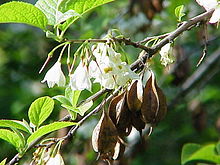
Heracleum maximum, commonly known as cow parsnip, is the only member of the genus Heracleum native to North America. It is also known as American cow-parsnip, Satan celery, Indian celery, Indian rhubarb, poison turnip or pushki.

Styrax is a genus of about 130 species of large shrubs or small trees in the family Styracaceae, mostly native to warm temperate to tropical regions of the Northern Hemisphere, with the majority in eastern and southeastern Asia, but also crossing the equator in South America. The resin obtained from the tree is called benzoin or storax.
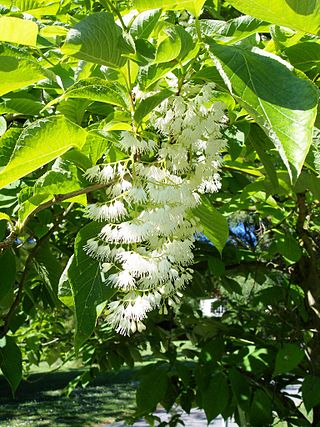
Pterostyrax, the epaulette tree, is a small genus of four species of deciduous large shrubs or small trees in the family Styracaceae, native to eastern Asia in China and Japan. They grow 4–12 m (13–39 ft) tall, with alternate, simple ovate leaves 6–17 cm (2–7 in) long and 4–10 cm (2–4 in) broad. The flowers are white, produced in dense panicles 8–25 cm (3–10 in) long. The fruit is an oblong dry drupe, with longitudinal ribs or narrow wings.

The Styracaceae are a small family of flowering plants in the order Ericales, containing 12 genera and about 160 species of trees and shrubs. The family occurs in warm temperate and subtropical regions of the Northern Hemisphere.
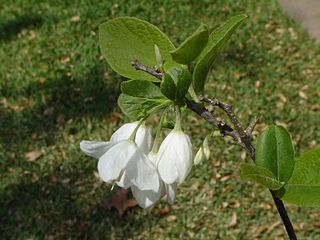
Halesia diptera, the two-wing silverbell or two-winged snowdrop tree, is a species in the family Styracaceae, native to the southeastern United States from South Carolina and Florida west to eastern Texas. It is cultivated as an ornamental tree.

Physocarpus, commonly called ninebark, is a genus of flowering plants in the family Rosaceae, native to North America and northeastern Asia.

Lycopus is a genus of herbaceous plants in the family Lamiaceae. The many species are known as water horehound, gypsywort, and bugleweed and are native to Europe, Asia, Australia, and North America. The species are most often found in wetlands, damp meadows, and stream banks. Some of the wetland species have become endangered.
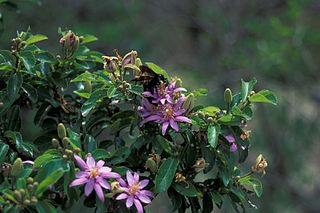
Grewia is a large flowering plant genus in the mallow family Malvaceae, in the expanded sense as proposed by the Angiosperm Phylogeny Group. Formerly, Grewia was placed in either the family Tiliaceae or the Sparrmanniaceae. However, these were both not monophyletic with respect to other Malvales - as already indicated by the uncertainties surrounding placement of Grewia and similar genera - and have thus been merged into the Malvaceae. Together with the bulk of the former Sparrmanniaceae, Grewia is in the subfamily Grewioideae and therein the tribe Grewieae, of which it is the type genus.

Euonymus fortunei, the spindle, Fortune's spindle, winter creeper or wintercreeper, is a species of flowering plant in the family Celastraceae, native to east Asia, including China, Korea, the Philippines and Japan. E. fortunei is highly invasive and damaging in the United States, causing the death of trees and forest in urban areas.
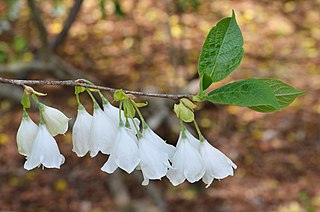
Halesia tetraptera, commonly known as the common silverbell or mountain silverbell, is a species in the family Styracaceae, native to the southeastern United States. It is cultivated as an ornamental tree.
Halesia macgregorii is a species of flowering plant in the family Styracaceae. It is endemic to southeastern China, where it grows at moderate altitudes of 700–1,200 m. It is threatened by habitat loss. Recent genetic evidence suggests it is probably more closely related to the genus Rehderodendron than to other species of Halesia; it may be transferred to that genus in the future.

Oenothera fruticosa, the narrowleaf evening primrose or narrow-leaved sundrops, is a species of flowering plant in the evening primrose family.

Malus angustifolia, or southern crabapple, is a species of crabapple native to the eastern and south-central United States.

Malus baccata is an Asian species of apple known by the common names Siberian crab apple, Siberian crab, Manchurian crab apple and Chinese crab apple. It is native to many parts of Asia, but is also grown elsewhere as an ornamental tree and for rootstock. It is used for bonsai. It bears plentiful, fragrant, white flowers and edible red to yellow fruit of about 1 cm diameter.

Rhus aromatica, the fragrant sumac, is a deciduous shrub in the family Anacardiaceae native to North America. It is found in southern Canada and nearly all of the lower 48 states except peninsular Florida.

Halesia carolina, commonly called Carolina silverbells or little silverbells, is a species of flowering plant in the family Styracaceae, native to the southeastern United States.

Halesiamonticola, the mountain silverbell, is a species of flowering plant in the small family Styracaceae. This large deciduous shrub was originally included in H. carolina, but was identified first as a subspecies by Rehder in 1914 and then as a species by Sargent in 1921. More recently, some authoritative sources regard it only as a subspecies or variety, while other authoritative sources regard it as a species, as it is treated here.

Styrax grandifolius, the bigleaf snowbell or bigleaf storax, is a plant species native to the southeastern United States, ranging from Virginia south to Florida and west to Texas and Missouri. The plant grows as a deciduous shrub or tree up to 6 metres (20 ft) high, and is most commonly found in upland forests of the southeast's piedmont. As the specific epithet suggests, the species has larger leaves than sympatric Styracaceae, with alternate, obovate leaves up to 14 cm long and 10 cm wide that are densely pubescent underneath. Flowers are borne during early summer in racemes containing up to 20 flowers.
Bigelowia nudata, the pineland rayless goldenrod, is a species of North American flowering plant in the family Asteraceae. It is native to the coastal plain of the southeastern United States.
Perkinsiodendron is a genus of flowering plants belonging to the family Styracaceae.
